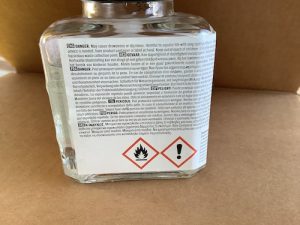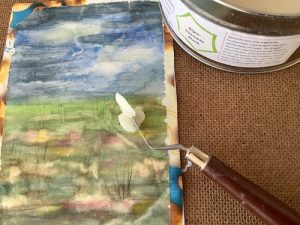Varnish and lacquer
The finishing!
Normally a watercolour painting is made on special paper, preferably 300 grs and of 100% cotton. Because of this material, it is neatly hung in a frame and behind glass.
The disadvantage of this is that the glass can reflect, makes the colors duller and the frame is visible.

And that’s the beauty of canvas: no frame, no glass and therefore a direct line with whoever sees it. Honest, without gloss, without the intervention of any other material, BAM in your face.
But watercolor is fragile, can be made active again with a little water, so a good finish must be given, a seal, so that moisture and dirt have no chance to stain the painting. And there I got a bit lost between all that there is.
At first I just wanted to finish it all with an acrylic varnish. I also tried that with a small test canvas. But if you just unscrew the cap of the bottle, the chemicals hit you and you already know in advance: this is not environmentally friendly.

The print on the bottle is so small that I have to take out my magnifying glass to read that it can indeed hit your eyes, nose and throat (oh, I already knew that), and it can also make you dizzy and nauseous, to the point of vomiting. You have to use it in a well ventilated area and it will be harmful for the nature and environment for a very long time.
Thank you very much!
Aside from my personal dislike, it of course made no sense at all within the path I took to make the smallest possible footprint in our ecosystem with non-recyclable clothing and watercolors.
In search of something different. It should in any case not be water-based, because then you will immediately lose your beautiful watercolor when applying. Alcohol-based products are also excluded for that reason.
In a youtube video I saw Liz Chaderton, who knows all about “watercolor on canvas” and she was talking about Cold Wax. That is beeswax with resin (a hardener) and white spirit. That last one, I wasn’t too happy about that. The resin could be a natural resin…
I came to floor polishing wax, a combination of beeswax and carnauba wax. This comes from the carnauba palm and has a higher melting point than beeswax, which creates a more wear-resistant layer. NICE. Let’s take a look at the ingredients…. pure beeswax, carnauba wax, high-quality micro waxes and D60 (aromatic-free solvent with high flash point)
Sounds good, doesn’t it? Until I went to find out what D60 actually is… yes… a petroleum-based substance, also called hydrotreated light. I can’t get out of it. Apparently you need some kind of turpentine-like solvent to keep the polishing wax spreadable
Sounds good, doesn’t it? Until I went to find out what D60 actually is… yes… a petroleum-based substance, also called hydrotreated light. I can’t get out of it. Apparently you need some kind of turpentine-like solvent to keep the polishing wax spreadable.
I bought a jar of wax from a beekeeper online to see if this is it.

Next time the findings and the sequel to the finish